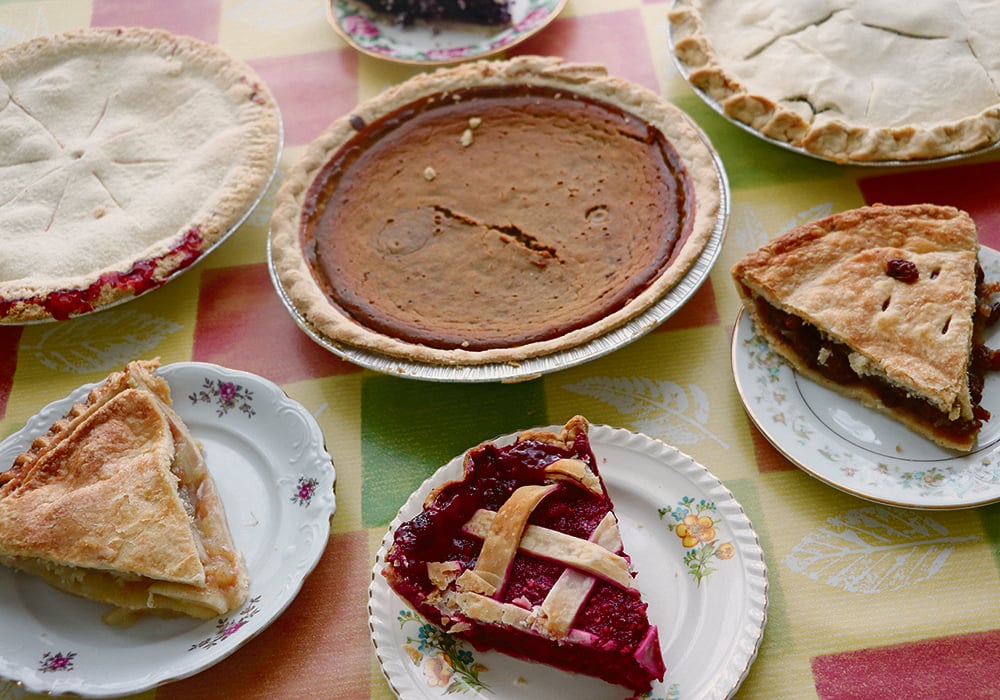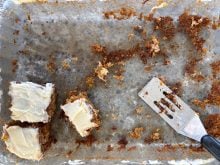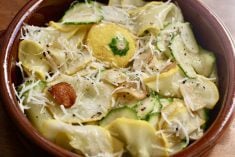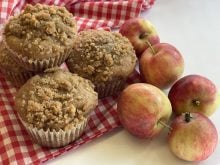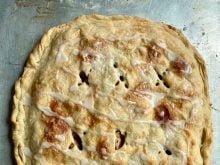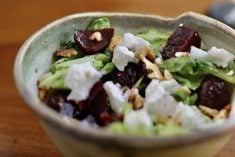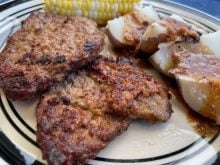In the early 1920s, one of a farm woman’s biggest challenges would be feeding the threshing crew in autumn.
Crews of 10 to 20 men and teenage boys would need to be fed three hearty meals and two or three coffee break lunches each day.
These meals were prepared on a coal and wood stove. The neighbour’s wife or daughter might come to help the farm wife and her daughters with the food preparation and teenage girls were often hired to help during the busy summer.
The crews were generally made up of local neighbours who would come to work in exchange for the farmer coming to help with their harvest. Thrashing crews also came up from North and South Dakota to help when their harvest was finished.
Not every farmer could afford a threshing outfit so steam engine, threshing machine, hay racks and crew would move from farm to farm. Some also travel with a cook shack to feed their crew. The federal government brought in additional workers by the train load from the east to help with the prairie harvest.
In the Sept. 11, 1924, issue of The Western Producer, Mrs. S.V. Haight of Keller, Sask., a regular contributor to the paper, shared tips on how to cook for the threshing crew.
Her first suggestion was “do not serve soup at noon, as it is too light a food to work on; but at night, when men come in tired and cold, there is nothing better to start the meal than a steaming bowl of soup.”
To make the soup, simmer cracked bones, gristle and water to cover the bones for three hours. The bones are removed, and the stock is skimmed to remove the fat.
Haight recommended “any left-over vegetables or gravies improve soup stock.” Other suggested additions were “creamed peas, creamed corn, rice, macaroni, chopped hard-boiled eggs, cabbage and parsnips. To any soup which does not contain milk or cream, may be added a spoonful of ketchup or chopped pickle, mashed turnip, baked beans, brown gravy, tomatoes, macaroni and tomatoes or macaroni and cheese (chopped fine).”
Her advice is that “left-overs served in this way are not left-overs at all, but an appetizing change.”
In addition to the soup, cold sliced meats, fried potatoes, salads and lots of fresh bread or buns would fill out the supper meal.
Haight stated that “however simple a meal is, there must be lots of it — in sight. Load the table with plain beet pickles, chopped pickle and plain cookies. Put the pie right on the table — lots of it — where the men can help themselves. Does it matter if each man eats two or three pieces?”
The most important thing was that the farm wife should “never be accused of being that most dreadful of ogres — “a stomach robber”.
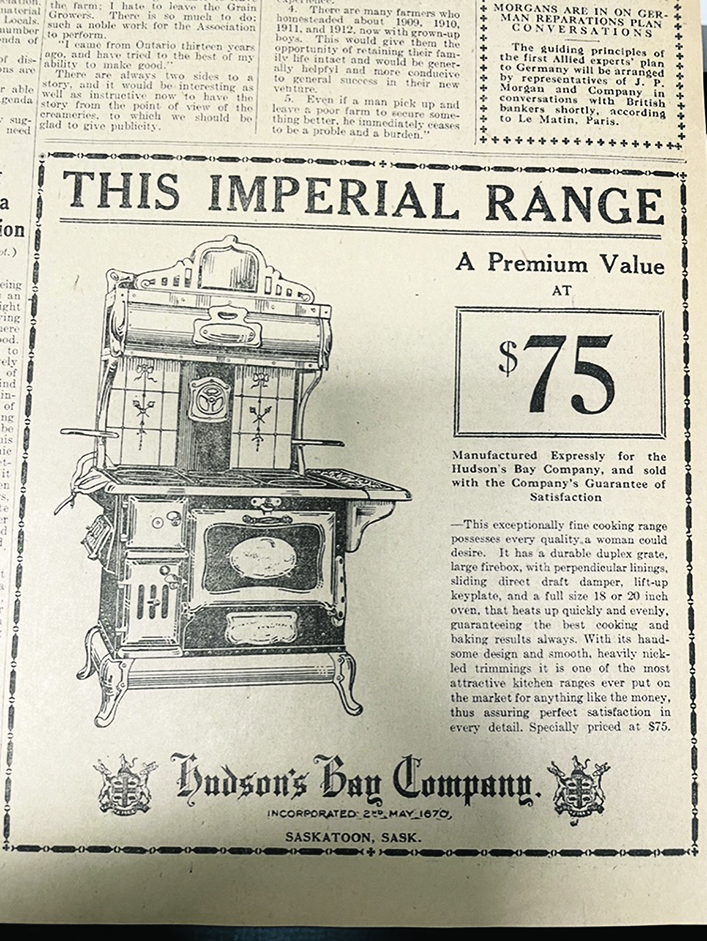
My mother-in-law, Maria (Leiman) Deobald, worked as a hired girl on the Ernest Lightbody farm near Shamrock, Sask. She held Mrs. Lightbody in high regard, as she was very kind and well organized. Maria learned how to make a big batch of pie dough mix for quick pie assembly that was very useful when feeding the threshing crew. The concept behind this is to mix up the flour, salt and lard ahead of time and chill it. When pies need to be made, it is easy to add the liquids and the dough is ready to use. The mix would have been stored in a cool cellar in a covered crock. Today, this mix could be stored in the fridge or freezer.
Pie Pastry Mix
Yields three large or four small two-crust pies.
- 6 c. flour 1.5 L
- 1 tsp. salt 5 mL
- 1/2 c. yellow sugar, pressed down 125 mL
- 1 lb. lard 454 g
- 1 egg
- 1/4 c. vinegar 60 mL
- cold water or cold milk
Sift flour into a large bowl, add salt and sugar, mix well. Add cold lard and cut in with a pastry blender or two knives until mixture resembles fine breadcrumbs. Chill at least 20 minutes.
To make pie crusts place flour lard mixture in a large bowl. Beat one egg in a cup, add vinegar and water or milk to three-quarter cup mark. Add slowly, as much as needed to the flour mixture, combining by mixing with a fork until the mixture comes together to form a dough.
Gently bring mixture together with your hands, shape into six discs. Wrap in plastic wrap or parchment paper and chill at least 20 minutes before using.
To make a large batch of pastry mix, make multiple recipes of the flour, salt, sugar and lard as described above. This requires the most effort. Place each batch in a sealed plastic bag and label with the amount of liquids needed. Refrigerate or freeze until needed.
Saskatoon Berry Pie
Saskatoon berries are a wild fruit found in the coulees and river valleys of the Prairies. They were enjoyed in pies, cakes and muffins, and also canned to serve as fruit. Yield: 1 large 10-inch pie, 10 or more servings
Saskatoon berry filling
- 1/3 c. flour, depends on the juiciness of your berries, add up to 1/2 cup/125 mL) 75 mL
- 1 c. sugar 250 mL
- 1/4 c. brown sugar, pressed down 60 mL
- 1/2 tsp. cinnamon 2 mL
- 1/4 tsp. nutmeg 1 mL
- 6 c. fresh saskatoon berries, if frozen thaw to room temperature 1.4 L
- 1/4 c. lemon juice 60 mL
- 1/4 tsp. almond extract 1 mL
- 3 tbsp. butter 45 mL
Make filling first to allow time to cool. Whisk together flour, sugar, brown sugar, cinnamon and nutmeg.
In a large saucepan, bring saskatoon berries and lemon juice to a gentle boil.
Stirring constantly, gently stir in the flour, sugar and spices. Cook for one minute after last of dry ingredients have been added. Filling should have thickened.
Remove from heat, stir in almond extract and butter.
To avoid a soggy crust cool filling to room temperature before adding to pie crust.
When cool, pour into prepared unbaked pie crust. Top with second pastry round, tucking edges of dough under bottom crust and flute edges together using fingers or a fork. Brush with egg wash made by whisking together one large egg yolk and one to two tbsp. water.
Lightly sprinkle sugar over top of egg washed pie if desired. Slit a one-inch hole in the middle of top crust to allow steam to escape or make a lattice pie crust for the top.
Chill pie in refrigerator for 20 to 30 minutes. This helps create a flaky crust. Place pie on a cookie sheet to catch any drips. Bake at 400 F (200 C) for 20 minutes, reduce heat to 350 F (180 C) and bake 45 to 60 minutes or until filling bubbles and thickens.
If crust gets too dark around the sides, cover edges with strips of aluminum foil and continue baking until rest of pie is completely baked. Cool completely before serving. Adapted from rockrecipes.com.
Sourdough starter
In the Dec. 21, 1995, Emmie Oddie column, a reader, M.D from Sedgewick, Alta., wrote to share that a homemade yeast had been given to her late mother-in-law in 1924 by a woman in a threshing cook car from North Dakota. The reader’s family had kept the yeast starter going for more than 70 years and it was still being used by a granddaughter. The reader wondered how the original starter was made.
Emmie shared the following homemade yeast or sourdough starter recipe.
This starter makes delicious bread and buns.
- 2 medium potatoes 225 g
- 2 c. boiling water (use non-chlorinated water) 500 mL
- 1/2 tsp. salt 2 mL
- 1 tbsp. sugar 15 mL
- 2 1/4 tsp. traditional yeast 8 g
- 2 c. sifted all-purpose flour or whole wheat flour 500 mL
Cook potatoes in boiling salted water. Drain and save liquid. Mash potatoes well. Add water to potato water to make 2 cups (500 mL) liquid. Cool to lukewarm; stir in sugar and yeast until dissolved, stir in potatoes.
Cover with a towel and set in a warm place for two to three days, stirring occasionally.
When mixture smells fermented, beat in flour until smooth. Cover and set in a warm place overnight.
Use in favourite bread or bun recipe. One cup of starter equals 2 1/4 tsp. of yeast or one eight-gram package.
Pour the rest of the starter into a large jar, cover and store in the refrigerator. If liquid separates from starter, stir well to mix in.
To use again remove from refrigerator the night before baking. Beat in one cup flour and one cup lukewarm potato water.
Cover and set in a warm place overnight. If starter gets down to one cup, add flour and potato water to it and sit overnight to build back up again before refrigerating.
Betty Ann Deobald is a home economist from Rosetown, Sask., and a member of Team Resources. Contact: team@producer.com.


